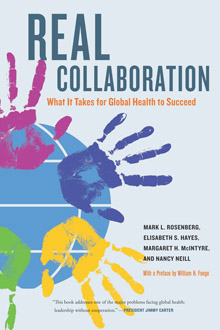Campus News
September 7, 2010
Hooked on collaboration for global health

Mountain climbing teams are hooked together so that support is always available if one member falters. Collaboration is essential to reach the goal; the communicating connection ensures success. The Task Force for Global Health, an Emory affiliate, is hooked on collaboration as the vital element in combating health threats worldwide. Using the mountain climbing analogy, Emory faculty member and Task Force President Mark Rosenberg takes on the issue in “Real Collaboration: What It Takes for Global Health to Succeed” (University of California Press, 2010), co-authored by colleague Elisabeth Hayes and public health experts Margaret McIntyre and Nancy Neill.
Some of the most successful collaborations in global public health have included eradicating smallpox in India; immunizing 80 percent of the world’s children; eliminating polio in the Americas; and treating more than 46 million people for river blindness. In more than 100 interviews with world leaders involved in these and other global health issues, the authors identify the elements of a successful partnership.
The authors provide readers with a “partnership pathway.” In each stage of their climb, mountaineers have to complete a number of challenging tasks to reach the peak. Similarly, in global health partnerships, the three stages of the partnership pathway will lead to reaching the “last mile,” achieving the goal. At that point, control can be passed to the appropriate authority.
“This book was written to be a practical guide — a tool that would be useful for climbers during their ascent and descent,” says Hayes.
“Real Collaboration” guides its users through the stages of collaboration and is accompanied with a DVD with video presentation about collaborative efforts, as well as a toolkit to support the design and implementation of coalitions.
The most critical challenges partnerships face are cultural and social differences. Team members represent cultures and agendas of their own countries or organizations and incorporate their own personal styles and self-interests.
“We have been trained as scientists and researchers, but we have not been trained in getting people to work together,” says Rosenberg. “Often partners talk about measurable objectives and numbers reached, but few discuss how different personalities interact — why one person was difficult to work with, why another was an extraordinary leader — or how to navigate the different personality types to promote inter-organizational collaboration.”
Adequate funds are needed to develop and maintain these partnerships.
“Sustained funding that allows collaboration to happen and promotes long-term commitment is essential,” Hayes emphasizes. “Adequately budgeting for the partnership pathway’s elements in the funding requirements would help to assure success of the project.”
Rosenberg likens global health collaboration to a marriage: “Partnerships are easy to get into, but it’s very hard to make them work. Real collaboration happens when we are hooked together with a connection strong enough to get us through the arguments and ups and downs that every partnership inevitably faces.”
The book is dedicated to Task Force founder William Foege, Emory professor emeritus and senior fellow at the Gates Foundation. Foege’s insightful preface sets the stage for a frightening list of global diseases that can only be addressed through effective collaboration.
